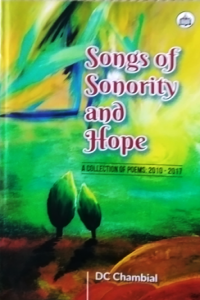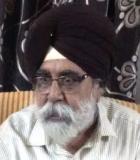Creation and Criticism
ISSN: 2455-9687
(A Quarterly International Peer-reviewed Refereed e-Journal
Devoted to English Language and Literature)
Vol. 05, Joint Issue 18 & 19 : July-Oct 2020

Book Review
Songs of Sonority and Hope by DC Chambial
DC Chambial. Songs of Sonority and Hope: A Collection of Poems: 2010-2017. New Delhi: Authorspress, 2018. Pp. 152, Price: Rs. 295/-, ISBN: 978-9387651234
Reviewed by H. S. Bhatia
D. C. Chambial did his PhD in Indian English Poetry. He retired from HP Education Service after 38 years of service. He has won several awards for his poetry from India and abroad. Dr. Chambial is one of the major contemporary poets and critics. He has penned ten books of poems and two of criticism on the poetry of two major Indian poets. His eight volumes of poetry have been published in one book under the title: “Words—1979-2010” (2012) and the other two under the title: Songs of Sonority and Hope (2018).
The very first poem, “Temple” from Songs of Sonority and Hope, sets the tone of Chambial’s poetry. However, it seems relevant to mention here the great dichotomy that exists in the minds of certain critics, who, on the one hand, demand complete transparency or comprehensibility of a poem, and, in the same breath, declare that a poem is independent of the poet, being a living organism. Now, an organism has life, and life is always a mysterious thing, all the discoveries of DNA, Genome and the like notwithstanding. So, how can they reject the element of “mystery” in a poem? Sometimes, they thoughtlessly dismiss such a poem as ‘obscure’. It should be borne in mind that every poet is an ocean of thoughts and ideas and has his own style and rhythm, and if a so-called critic fails to find any merit in a work, it is the failure of the critic, not of the poet.
Chambial unmasks the hollow life of the modern world in “So Goes the World” (42): “This is the way of the wisest smart world / To work with faces veiled to shun the truth;” and “Man Prefers Matter”(43) highlights man’s deviation from godly ways: “God made Man, they say, in His own image; / Man rebelled, strayed away for doing damage.” He is unfailingly rhythmic and usually very musical and soothing in his free verse, but he is no less adept in the use of rhyme as in the lines mentioned above, as in many other poems.
Chambial laments man’s greed and expresses disenchantment with overambitious human beings with their sky-rocketing wishes and dryness of human emotions: “The riches sought in this lusty world, / overnight one longs to pluck the brightest star, …. All human milk is dried in human heart” (“This Lascivious World” 44). There is a similar theme in “Man for Mammon” (45): “Man has meddled not with mortals only, / Dug deep into the bowels of Earth as well.” Then in “The Thick of Night”(47), he grumbles that “The heavenly tick is lost for good.” His indignation at humans’ mischievous ways takes the shape of an almost crescendo in lines like “We’re living in a land / that abounds in / wolves, hyenas and jackals” (“We are Living…” 51). The same idea recurs in “Man for Man” (55): “Man’s mad— / Money. / Wild beast of prey.”
Despite all the human failures and deficiencies, Chambial has a firm faith in the bright future of mankind for which man has to struggle, no doubt: “True, “Life is a nine days’ wonder”, / Live it, live it with winning thunder!” (“Live with Winning Thunder” 59). However, he does not have a blind belief in this “Winning” spree, and disapproves a life of hurry and scurry: “Images of life / full of rainbow / lost in the gale,” (“Harried Hurry” 62). In lines such as these, and numerous others spread across the volume, Chambial’s love for using symbolist language is easily discernible. He is philosophical at places, but without any embarrassing expostulations: “Soul and soul stout / Atmaiva Pramatma / Brethren—His creation” (“Stunned Mirages” 65).
‘Brevity is the soul of wit’, and Chambial’s poetry is a model of this virtue. To be sure, at places, he is more deeply contemplative in the second part: “Fusion of light with Light / leaving behind glitters and glimmers /of gaudy days and ways /….. Light in dark; Dark in light” (“Goal’s at Hand” 101). We come across ‘beauty’ and ‘divine bliss’ everywhere in his poems: “on the beauty divine was he fed” (“The Beauty Divine” 103). The theme of “Om” recurs in the second part, but here the poet thinks more about the emergence of the cosmos than “In search of / true / self” (“Om”, 29). “The Cosmos rolled out / In the original form” (“Om”, 108). In several poems Chambial celebrates “Love”, but in “Love lasts Eternity” (109), it is “Love, a sentiment of oneness.” Here, I have to assert that expression or celebration of “Sentiment” within a limit is neither a fault nor a derogatory presentation. In several poems, especially, towards the end of the volume, there are themes most consummately brought out like patriotism significance of “Dissent” (145), the question of conscience: “Does your conscience not prick You?” (144) and stoicism: “Why the fear of death? / Why the joy of birth? / Let’s welcome both / with stoic stance of a seer!” (“Stoic Stance” 110).
In a few words, Chambial is an all rounder, who smells, enjoys and cherishes every flower in the garden of life, and shares his findings, feelings and experiences with one and all in a spirit of altruism.
Note: Numbers after verses refer to lines and after title of the poem(s) to page.
 About the Reviewer:
About the Reviewer:
Prof. H. S. Bhatia is a prolific writer of English language and literature. He resides at 284/301, St No. 1, Near Big Byte, Nandi colony, Khanna– 141 401 (Pb), Mob. +919872551552.


